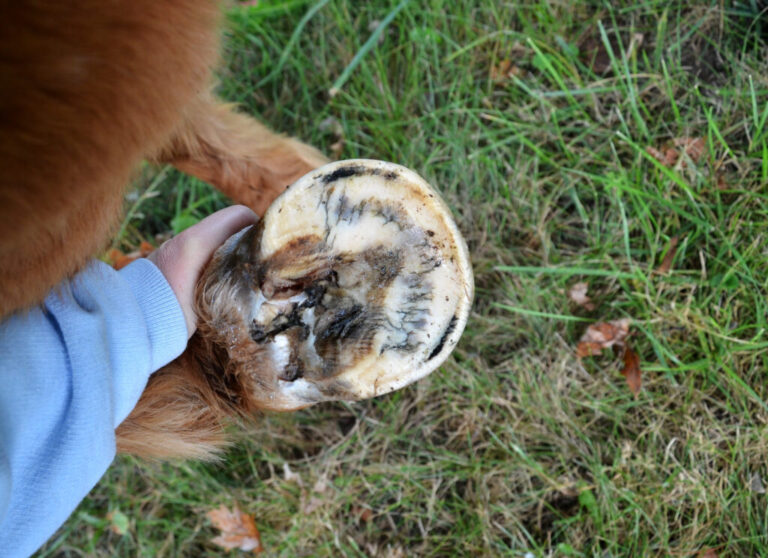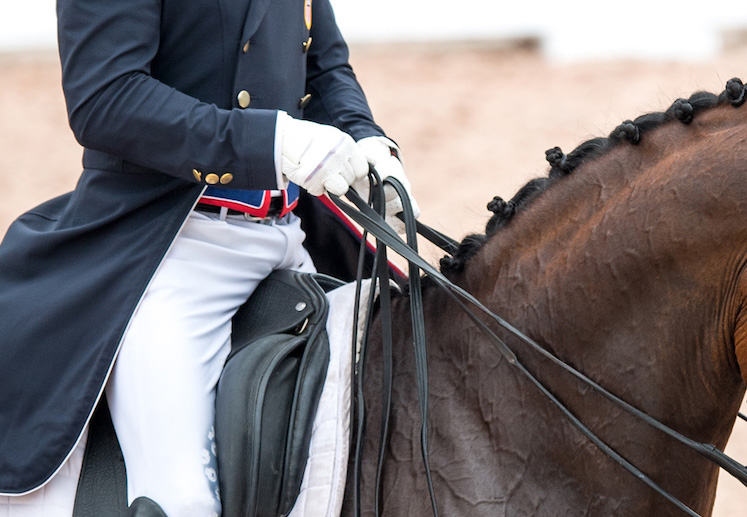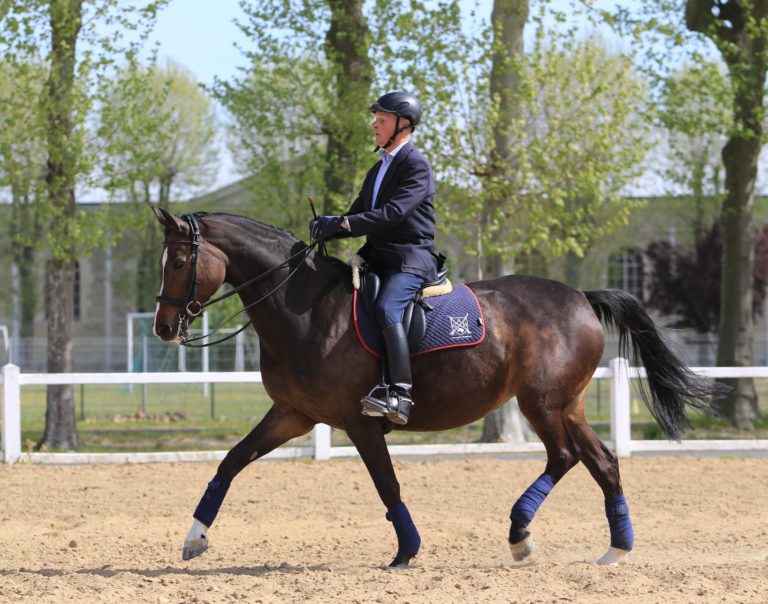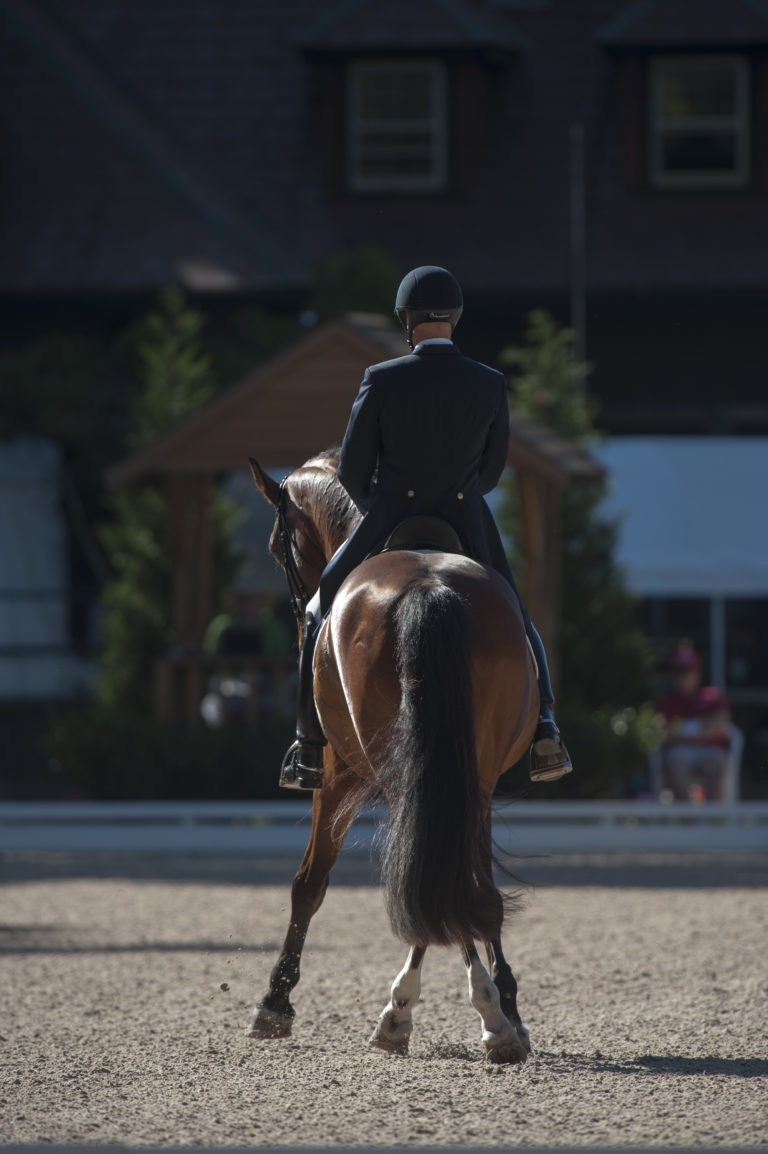
My horse has a suspensory injury” is a commonly heard statement in the equestrian world when a horse is suffering from lameness. What is heard less often is how the injury may have been prevented and the intricacies of what lies ahead on the road to recovery. Having experienced a two-year healing journey for a severe deep-flexor-tendon injury with my own horse, I always keep my radar up regarding information about equine health, particularly leg injuries. So when I was invited by my veterinarian to attend a University of California Davis (UC Davis) event in Los Angeles about sport-horse injuries I seized the opportunity.
Dr. Claudia Sonder, director of the Center for Equine Health at the UC Davis School of Veterinary Medicine, presented the informative educational program. I was fascinated by the university’s findings from a national study that yielded discipline-specific injury data and confirmed that dressage horses are predisposed to suspensory-ligament injuries. I also gleaned a better understanding of suspensory ligaments. “In horses, the suspensory ligament is a strong band of stiff collagen fibers that lies along the back of the cannon bone between the splint bones and it helps to suspend the fetlock during limb-loading. It originates at the top of the cannon bone and splits two thirds of the way down, sending branches to each of the proximal sesamoid bones at the back of the fetlock joint. The primary function of the suspensory ligament is to prevent excessive extension of the fetlock joint during the weight-bearing phase of the stride,” said Dr. Sonder.
My intrigue with the presentation led to a road trip to UC Davis in Northern California to learn more for this story. The university is ranked No. 1 in the world in veterinary medicine and is a global leader in equine medical research and education. Dr. Sonder collaborates with a team of 220 veterinarians and nearly 600 veterinary students while overseeing a herd of 200-plus horses and a 113-acre facility at the Center for Equine Health. “We are working on several projects to improve the prevention, diagnosis and treatment of suspensory-ligament injuries in horses, including studies of arena footing and fetlock drop, advanced imaging techniques, regenerative medicine to treat tendon and ligament injuries and objective assessment of lameness,” she explained.
Biomechanics and How Injuries Occur
Key to the prevention of injuries is an understanding of how they occur. Dr. Sonder explained that any condition that increases the amount of fetlock drop in the horse stretches the suspensory ligament and when the stretch exceeds the elastic capacities of the collagen fibers, they tear. “We know that horses will overuse their suspensory ligaments to minimize loading painful parts of their limbs, such as sore heels or hocks,” she said. “Thus, suspensory ligament injuries can be primary or secondary, depending upon the circumstances. We recognize that horses can have significant suspensory-ligament strain or fiber tearing with minimal overt lameness, which is why so many horses develop chronic suspensory-ligament injuries.”
Biomechanics (motion study and the mechanical forces affecting the body) in particular can be a road map to longevity and sustaining a healthy equine partner. A conversation with Dr. Sue Stover, a veterinarian and professor at UC Davis who specializes in musculoskeletal biomechanics, repetitive use injuries and equine locomotor anatomy, shed light on the complexities of her field.
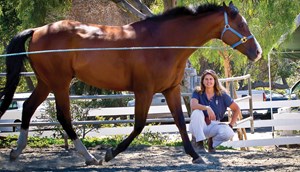
Dr. Stover explained that the suspensory apparatus (the ligament and its two branches) holds up the fetlock and the parts are like links in a chain. If any part of it is damaged, the whole thing will fail. According to Dr. Stover, injuries usually occur because the loads are too great or the intensity of training is too high for the fitness level of the horse. “Things we can do to keep the loads low are to provide optimal surfaces to work in [dirt or synthetic], shoes that will help the horse adapt and a training regime at a level that enhances the horse’s musculoskeletal adaptation,” she said. “For example, when exposing a dressage horse to a new movement for the first time, whether it is as simple as bending or as advanced as passage, stop and reward incremental progress to let the horse adapt versus doing it over and over again. When there is resistance, listening to the horse and not pushing a horse through discomfort is very important. I cannot emphasize that enough. Always step back a little bit and let the horse heal or catch up then move on. There is no more sensitive indicator of that than being an astute observer. Also, do not train on anti-inflammatory medicine to make the horse feel better because the body is not ready to do the work.”
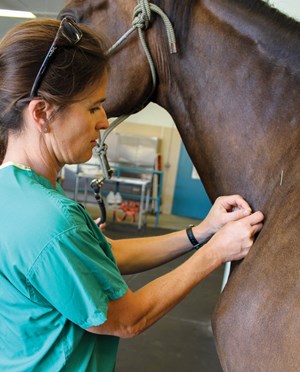
To strengthen muscles, ligaments, tendons and bones, as with humans, a horse has to have a higher level of activity. According to Dr. Stover, short intervals are ideal and, though it takes a lot of work to get a horse fit for his job, substantially less work is required to maintain the desired fitness level. In fact, she cautions that horses can be very susceptible to injuries when they are overworked at their optimum fitness level and therefore recommends a maintenance fitness program instead of a constant intensive training program. “The body is continually regenerating but if damage is too extensive, healing cannot keep up, resulting in inherent weakness and injuries. Patience is critical in the training process for injury prevention and the overall well-being of horses.”
Symptoms and Diagnosis
Since horses instinctively mask pain for survival, injuries can be difficult to diagnose. Suspensory-ligament injuries vary and, though dressage horses are susceptible to them in the front legs, they are more prevalent in the hind legs due to how they are asked to carry themselves with more weight on the back end. According to the UC Davis veterinary faculty, there are subtle indications before lameness actually occurs, such as an unwillingness to collect, a delay in the changes or difficulty changing direction with a particular movement such as a pirouette. When lameness does occur due to a suspensory issue, counter to what is typical of tendon injuries, there can be pain without heat or swelling and if there is heat it can be elusive. In severe incidents, there is a drop in the fetlock.
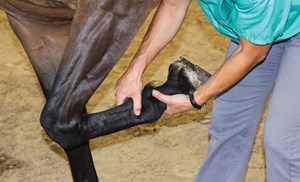
Ultrasound is the primary way to diagnose a suspensory-ligament injury in many horses. According to Dr. Mary Beth Whitcomb, a veterinarian and UC Davis associate professor who is considered to be one of the nation’s leading authorities on equine ultrasound, it is very important that owners and trainers communicate changes in a horse’s performance with veterinarians and not assume that because a horse is lame it is a suspensory injury. “Before doing an ultrasound it is critical for the veterinarian to localize the lameness first,” said Dr. Whitcomb. “The damage of a mild injury can be hard to see as compared to moderate and severe injuries because muscle appears dark and can be misinterpreted as an injury. MRI is an option, but availability is often limited, it requires anesthesia and it is expensive.”
During rehabilitation, Dr. Whitcomb generally recommends ultrasound rechecks every two months to make sure the injury is improving. “Sometimes injuries do not look better on ultrasound, but if they appear stable and not worse that is good.”

Integrative Medicine And Rehabilitation
The UC Davis equine veterinary team takes a whole horse approach to medical care and the treatment of injuries.
According to Dr. Sarah le Jeune, a boarded surgeon, sports-medicine specialist, certified chiropractor and acupuncturist, they have developed a service at UC Davis called integrated sports medicine. “This basically combines western medicine with complementary therapies, such as acupuncture and chiropractic,” said Dr. le Jeune. “Part of what we do with acupuncture is palpation of acupuncture points on the body, neck and the back. Sensitivity in certain points can indicate that something is going on before the horse is actually lame because we have found in studies that there is a direct correlation between back pain and lameness. If a horse is dealing with a leg issue, particularly a suspensory issue, it is going to change how it is using itself and that is going to affect the back. If a horse has subtle signs, I palpate the legs to make sure something is not cropping up. I then do a full lameness exam that includes flexion tests. If I don’t find anything there then I am going to assume it is just muscle-pain- or saddle-fit-related problems, which are affecting the efficiency of movement.”
The university’s research confirms that the primary reason that dressage horses are predisposed to suspensory-ligament injuries is because they are constantly asked to load the hind end to be light in the front end to perform dressage movements. “That takes a lot of core strength to be able to do that. I think many horses have not been able to develop that core strength sufficiently so they are just loading the hind limbs and the suspensory apparatus, which is always under tension when the legs are weight-bearing. It is very important to make sure that the animal is able to do the work it is being asked to do. Otherwise, if they are not able to do it by engaging certain muscle groups that help support the back and the hind end then they are loading a structure in a supraphysiological way and the suspensory apparatus will be the first to go. It is the most highly stressed structure in the leg of a horse,” said Dr. le Jeune.
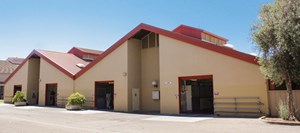
For serious suspensory injuries, Dr. le Jeune recommends developing a rehabilitation program with a veterinarian that includes stall rest, hand-walking, icing, anti-inflammatories and therapeutic shoeing. When available, hydrotherapy is often introduced to the regime to offer partial weight-bearing to support the leg as it recovers to eventual full weight-bearing. The school of veterinary medicine is also committed to researching the benefits of regenerative medicine, shockwave therapy and therapeutic laser on suspensory healing.
A typical rehabilitation schedule for a severe injury is stall rest with hand-walking five to 10 minutes per day for the first couple of months. Over a period of six to nine months, controlled hand-walking is slowly increased, depending upon the degree of lameness and how the injury looks with ultrasound. After successfully reaching one hour of sound hand-walking, the horse can begin under saddle work at a walk. Trot and canter work are gradually introduced with regular rechecks along the way.
“Rehabilitation involves changing the work so that you try to do work that is easier for the horse to strengthen other areas to help compensate for weaknesses. You will probably be hand-walking for several months, depending upon the severity of the injury, before gradually moving into work at other gaits. The faster the horse is going, the greater the load is on the suspensory, which is why we want them walking initially. Firm footing is also really important so the fetlock does not drop.”
Dr. le Jeune also stressed the importance of fitness and ideal body weight. “Keeping a horse lean and fit is really important. If you take an unfit horse and ask it to do things it should not physically be doing, that is going to cause issues. Being overweight is a problem too. Any increased weight will increase stress and tension on the limbs, particularly the suspensory apparatus. These are not injuries that occur from one day to the next. They are overload injuries that occur over time and there are subtle signs that develop. Initially, the horse might be reluctant in certain dressage movements, depending upon which leg is affected. That is where a good trainer is important in helping to determine if there is a pain issue or a training issue. And, if pain is related to the change in a horse’s behavior, it is very important to have a veterinarian check the horse early on.”
To download the UC Davis School of Veterinary Medicine’s Suspensory Ligament Injuries publication, visit vetmeducdavis.edu/ceh/publications/special_issues.cfm
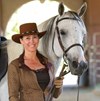
Diane E. Barber lives in Los Angeles and is a lifestyle writer, interior designer and dressage enthusiast. She has an affinity for Spanish horses and travels regularly to Spain to train with Olympic medalist Rafael Soto.
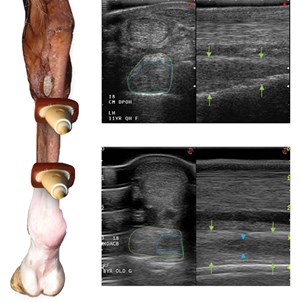
Studying an Ultrasound Image
The photo at left is the leg of a horse with ultrasound transducer placement to obtain images. The ultrasound images (right) show suspensory-ligament body injuries from two different horses. The top ultrasound image is a severe injury of the suspensory-ligament origin (location of the upper ultrasound transducer) in the hind limb. The suspensory ligament is outlined in green. The blue outline shows the hypoechoic (dark) tissue that indicates injury. The right side of the image shows the fiber pattern where a few normal fibers are seen near the top arrows, but the majority of the ligament has short fibers that are consistent with fiber tearing. The lower ultrasound image shows a moderate injury of the suspensory-ligament body before it divides into its two branches (location of lower ultrasound transducer) but from a forelimb. There is a dark oval area (blue outline) within the suspensory-ligament body that is consistent with a core lesion. Abnormal fiber pattern is also seen on the right side of the image (blue arrows). —Mary Beth Whitcomb, DVM, associate professor, Large Animal Ultrasound, University of California Davis
Suspensory-Ligament Injury Prevention
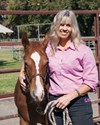
By Claudia Sonder, DVM, Director, Center for Equine Health, UC Davis School of Veterinary Medicine
Human and equine athletes struggle with soft-tissue injuries that fail to heal completely. In many cases, this is due to premature return to work before the ligament has regained tensile strength. Tendons and ligaments rarely heal with their original elasticity, which can further predispose them to re-injury. For this reason, detecting suspensory ligament strain early on, before significant tearing has occurred, goes a long way toward preserving overall soundness. There are a few variables that horse owners can control to minimize injury to the suspensory ligament:
- Work with your trainer to develop an exercise program that addresses both cardiovascular and musculoskeletal fitness. Musculoskeletal fitness takes much longer to develop, and a gradual work up to a performance goal is key. Working your horse on different types of footing also helps to develop suspensory-ligament strength. Trail rides or variations in footings at home can help prepare a horse for a new footing at a show.
- Be careful to avoid overtraining. Once a horse has achieved fitness, he takes surprisingly little work to maintain himself. A high number of repetitions of specific athletic tasks over short periods of time promote injuries because the suspensory ligament accumulates damage with insufficient time for the horse’s body to repair it. If a horse has mastered the intended level of a specific task on a training day, consider moving to another task rather than repeating the same task multiple times on that day. The musculoskeletal system of horses responds optimally to the level of the task achieved, not the number of times that the task was performed.
- Work with your veterinarian to identify any soundness issues that might predispose your horse to suspensory overload. Front heel pain and excessive fetlock drop are two problems that can overload the suspensory apparatus. Ask your veterinarian to demonstrate ligament palpation so that you can develop the skills to monitor your horse daily before and after work and note subtle changes in thickness or sensitivity.
- Provide your horse with a nutritional program that meets vitamin and mineral requirements and allows the horse to maintain a lean and athletic build. Horses that are overweight will overload musculoskeletal structures that function in shock absorption.
- Schedule a regular shoeing interval to maintain hoof−pastern angle, toe length and medial−lateral balance. As the toe gets longer, greater force is applied to the suspensory ligament during weight-bearing. If the heel is too long, fetlock drop (overextension) is augmented.
- If you notice a little swelling, some heat or a slight lameness—stop, look and evaluate. If your horse is not traveling or performing well on a given day, take time to check things out and involve your veterinarian if the problem does not resolve.


